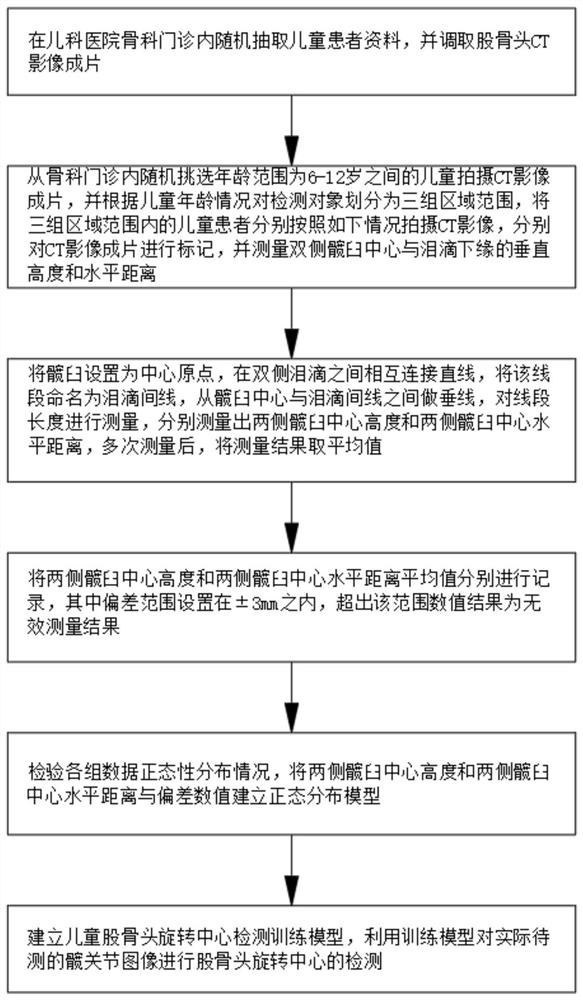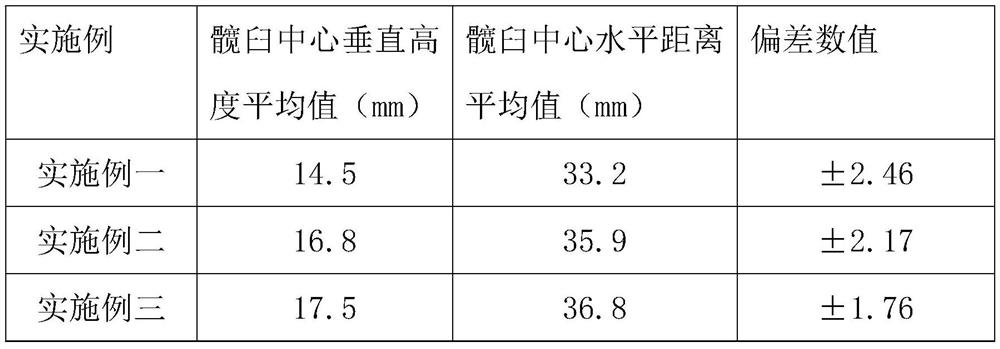Detection method for rotation center of femoral head of child
A technology of rotation center and detection method, which is applied in the field of image processing, can solve problems such as judgment errors and different age groups of children, and achieve the effect of increasing accuracy and avoiding special accidents
- Summary
- Abstract
- Description
- Claims
- Application Information
AI Technical Summary
Problems solved by technology
Method used
Image
Examples
Embodiment 1
[0044] The method for detecting the center of rotation of the femoral head in children comprises the following steps:
[0045] Step 1: Randomly select children's patient data in the orthopedic clinic of the Children's Hospital, and obtain CT images of the femoral head;
[0046] Step 2: Randomly select children between the ages of 6 and 12 from the orthopedic clinic to take CT images, and divide the detection objects into three groups of areas according to the age of the children, and divide the children in the three groups of areas Take CT images according to the following conditions, respectively mark the CT images into slices, and measure the vertical height and horizontal distance between the center of the bilateral acetabulum and the lower edge of the teardrop;
[0047] Step 3: Set the acetabulum as the origin of the center, connect a straight line between the teardrops on both sides, name the line segment as the line between teardrops, draw a vertical line from the center...
Embodiment 2
[0061] The method for detecting the center of rotation of the femoral head in children comprises the following steps:
[0062] Step 1: Randomly select children's patient data in the orthopedic clinic of the Children's Hospital, and obtain CT images of the femoral head;
[0063] Step 2: Randomly select children between the ages of 6 and 12 from the orthopedic clinic to take CT images, and divide the detection objects into three groups of areas according to the age of the children, and divide the children in the three groups of areas Take CT images according to the following conditions, respectively mark the CT images into slices, and measure the vertical height and horizontal distance between the center of the bilateral acetabulum and the lower edge of the teardrop;
[0064] Step 3: Set the acetabulum as the origin of the center, connect a straight line between the teardrops on both sides, name the line segment as the line between teardrops, draw a vertical line from the center...
Embodiment 3
[0078] The method for detecting the center of rotation of the femoral head in children comprises the following steps:
[0079] Step 1: Randomly select children's patient data in the orthopedic clinic of the Children's Hospital, and obtain CT images of the femoral head;
[0080] Step 2: Randomly select children between the ages of 6 and 12 from the orthopedic clinic to take CT images, and divide the detection objects into three groups of areas according to the age of the children, and divide the children in the three groups of areas Take CT images according to the following conditions, respectively mark the CT images into slices, and measure the vertical height and horizontal distance between the center of the bilateral acetabulum and the lower edge of the teardrop;
[0081] Step 3: Set the acetabulum as the origin of the center, connect a straight line between the teardrops on both sides, name the line segment as the line between teardrops, draw a vertical line from the center...
PUM
 Login to View More
Login to View More Abstract
Description
Claims
Application Information
 Login to View More
Login to View More - R&D
- Intellectual Property
- Life Sciences
- Materials
- Tech Scout
- Unparalleled Data Quality
- Higher Quality Content
- 60% Fewer Hallucinations
Browse by: Latest US Patents, China's latest patents, Technical Efficacy Thesaurus, Application Domain, Technology Topic, Popular Technical Reports.
© 2025 PatSnap. All rights reserved.Legal|Privacy policy|Modern Slavery Act Transparency Statement|Sitemap|About US| Contact US: help@patsnap.com


